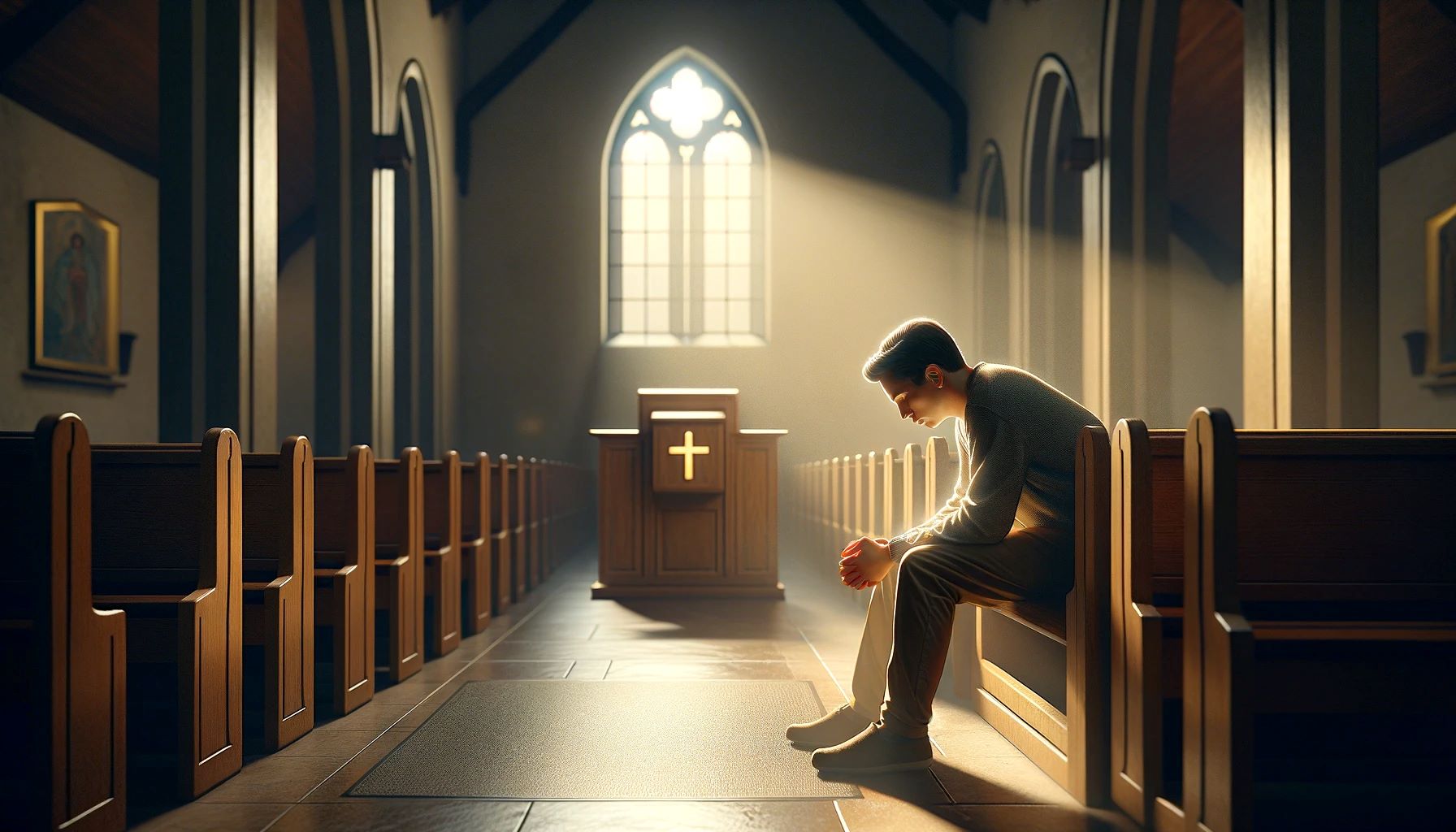Home>Special Themes>Why Do We Have The Advent Wreath


Special Themes
Why Do We Have The Advent Wreath
Published: February 13, 2024
Ericka Andersen, an editor at Christian.net, expertly merges digital strategy with content creation, focusing on faith and societal issues. Her communication skills enhance the platform's engaging narratives, fostering meaningful dialogue on belief's impact on society.
Discover the significance of the Advent wreath and its special themes in this insightful exploration of the tradition. Uncover the meaning behind the candles and the symbolism they hold.
(Many of the links in this article redirect to a specific reviewed product. Your purchase of these products through affiliate links helps to generate commission for Christian.net, at no extra cost. Learn more)
Table of Contents
Introduction
The Advent wreath is a cherished symbol of the holiday season, evoking a sense of anticipation and spiritual preparation as it graces homes, churches, and communal spaces. This timeless tradition holds a deep significance, representing the hope and expectation associated with the arrival of Christmas. As we delve into the history, symbolism, and modern adaptations of the Advent wreath, we will uncover the rich tapestry of traditions and beliefs woven into its existence.
The Advent wreath, with its vibrant greenery and flickering candles, serves as a poignant reminder of the imminent arrival of Christmas. Its presence kindles a sense of warmth and unity, bringing families and communities together in a shared sense of anticipation. This enduring symbol not only marks the passage of time but also encapsulates the spiritual essence of the holiday season.
As we embark on this exploration of the Advent wreath, we will unravel the historical roots that have shaped its significance, delve into the profound symbolism embodied by its elements, and illuminate the enduring tradition of lighting its candles. Furthermore, we will examine the modern adaptations that have breathed new life into this age-old custom, ensuring its relevance in contemporary celebrations.
Join us on a journey through time and tradition as we uncover the captivating story of the Advent wreath, a cherished emblem that continues to kindle the spirit of hope and joy during the festive season.
Read more: Why Do We Celebrate Advent?
The History of the Advent Wreath
The history of the Advent wreath can be traced back to pre-Christian Germanic and Scandinavian cultures, where the use of evergreen wreaths symbolized the eternal cycle of the seasons. These early wreaths, often adorned with candles, were lit during the dark winter months as a symbol of light and hope. As Christianity spread throughout these regions, the tradition of the Advent wreath evolved to incorporate Christian symbolism, eventually becoming intertwined with the observance of Advent.
The concept of Advent, meaning "coming" or "arrival," originated in the 4th and 5th centuries as a period of spiritual preparation leading up to the celebration of Christmas. The Advent wreath as we know it today emerged in 16th-century Germany, where both Catholics and Protestants adopted the practice of using a wreath with candles to mark the four weeks leading up to Christmas.
Initially, the Advent wreath featured a large white candle in the center, surrounded by four smaller red or purple candles. Each candle represented a different aspect of the Advent season, such as hope, love, joy, and peace. Over time, variations in the colors and symbolism of the candles emerged, reflecting the diverse traditions and interpretations of Advent across different Christian denominations.
The tradition of the Advent wreath gained widespread popularity in the 19th century and spread beyond Europe to become a cherished custom in Christian communities around the world. Its enduring appeal lies in its ability to encapsulate the essence of Advent, serving as a visual and symbolic representation of the anticipation and spiritual reflection that characterize this sacred season.
As the Advent wreath continues to hold a central place in the observance of Advent, its rich history serves as a testament to the enduring power of tradition and the timeless significance of symbols that unite and inspire communities across generations.
The Symbolism of the Advent Wreath
The Advent wreath is steeped in profound symbolism, with each element holding deep significance that resonates throughout the Advent season. At the heart of this cherished tradition lies a tapestry of symbols that encapsulate the spiritual essence of anticipation, hope, and the imminent arrival of Christmas.
Circular Shape
The circular shape of the Advent wreath represents eternity and the unending nature of God's love and grace. It serves as a powerful reminder of the eternal nature of the divine, offering a sense of continuity and unbroken connection with the sacred throughout the Advent season.
Evergreen Branches
The evergreen branches used to form the Advent wreath symbolize enduring life and immortality. In the midst of winter, when nature appears dormant, the vibrant greenery of the wreath serves as a testament to the promise of new life and the eternal presence of God.
Read more: Why Do We Do Penance During Advent
Candles
The candles adorning the Advent wreath hold profound symbolism, with each candle representing a different facet of the Advent journey. The first candle, often purple, symbolizes hope and serves as a beacon of light amidst the darkness. The second candle, also purple, represents love and embodies the warmth and compassion that permeate the season. The third candle, typically pink, signifies joy and rejoicing, heralding the imminent arrival of Christmas. The fourth candle, another shade of purple, represents peace and serves as a poignant reminder of the tranquility and harmony that accompany the birth of Christ.
Lighting of Candles
The act of lighting the candles on the Advent wreath each week symbolizes the progressive illumination of the world by the light of Christ. As each candle is lit in succession, the growing radiance mirrors the increasing anticipation and spiritual enlightenment that culminate in the celebration of Christmas.
Central Candle
The central candle, often white, is lit on Christmas Eve or Christmas Day and represents the culmination of the Advent journey—the birth of Christ. This candle, also known as the Christ candle, embodies the light of the world and serves as a focal point of reverence and celebration during the Christmas season.
Unity and Community
The Advent wreath, with its vibrant colors and flickering candles, fosters a sense of unity and community, bringing families and congregations together in shared reflection and anticipation. It serves as a visual and symbolic focal point, uniting individuals in a collective journey of spiritual preparation and joyful expectation.
In essence, the Advent wreath stands as a powerful symbol of faith, hope, and the enduring promise of Christmas. Its rich symbolism transcends time and tradition, offering a poignant reminder of the profound spiritual truths that resonate throughout the Advent season.
Read more: Why Is The Advent Wreath Green
The Tradition of Lighting the Advent Wreath
The tradition of lighting the Advent wreath is a cherished ritual that unfolds over the course of the four weeks leading up to Christmas. Each Sunday during Advent, a candle on the wreath is ceremoniously lit, marking the progression of time and spiritual preparation for the celebration of Christ's birth. This timeless tradition holds deep significance, serving as a poignant reminder of the enduring hope and anticipation that permeate the Advent season.
On the first Sunday of Advent, the initial candle, often purple, is lit to symbolize the light of hope. This act of kindling the first flame represents the dawning anticipation of the coming Messiah, infusing the surroundings with a sense of optimism and expectation. As the first candle flickers to life, it heralds the beginning of the Advent journey, inviting individuals and communities to embark on a period of introspection and spiritual readiness.
The following Sunday sees the lighting of the second candle, also purple, which represents the theme of love. As the glow of the second candle joins the radiance of the first, it serves as a poignant reminder of the boundless love embodied by the impending arrival of Christ. The intertwining flames of hope and love illuminate the path of spiritual preparation, fostering a sense of warmth and compassion within the hearts of those who gather around the Advent wreath.
On the third Sunday of Advent, the ambiance is further enlivened as the pink candle, symbolizing joy, is ceremoniously lit. The vibrant hue of the third candle infuses the surroundings with a palpable sense of rejoicing, signaling the nearness of Christmas. As the flickering flame of joy dances alongside the candles of hope and love, it encapsulates the spirit of jubilation that accompanies the imminent arrival of the Messiah.
The fourth and final Sunday of Advent sees the lighting of the last purple candle, representing peace. As the glow of the fourth candle joins the ensemble, it evokes a profound sense of tranquility and harmony, underscoring the imminent fulfillment of the Advent journey. The intertwining flames of hope, love, joy, and peace converge, casting a luminous glow that illuminates the path to the long-awaited celebration of Christmas.
As the Advent season culminates, the central candle, often white and known as the Christ candle, is lit on Christmas Eve or Christmas Day. This act of kindling the Christ candle represents the culmination of the Advent journey—the birth of Christ. The radiant glow of the central candle serves as a focal point of reverence and celebration, embodying the light of the world and heralding the joyous arrival of Christmas.
The tradition of lighting the Advent wreath, with its progressive illumination of candles, serves as a poignant visual representation of the spiritual journey towards Christmas. Each flickering flame symbolizes a distinct facet of the Advent season, weaving together a tapestry of hope, love, joy, and peace that culminates in the radiant celebration of Christ's birth. This timeless tradition continues to unite families and communities in a shared sense of anticipation and spiritual reflection, fostering a deep connection to the enduring significance of the Advent season.
Modern Adaptations of the Advent Wreath
In contemporary times, the timeless tradition of the Advent wreath has undergone modern adaptations that have breathed new life into this cherished custom. These adaptations reflect the evolving cultural and religious landscape, offering innovative ways to engage with the rich symbolism and spiritual significance of the Advent season.
One notable modern adaptation of the Advent wreath involves the incorporation of alternative materials and designs. While traditional wreaths feature evergreen branches and candles, modern interpretations often embrace diverse elements, such as minimalist metal or wooden structures adorned with symbolic ornaments. These contemporary designs cater to a wide range of aesthetic preferences, allowing individuals and communities to personalize their Advent wreaths while preserving the core symbolism of the tradition.
Furthermore, the use of environmentally friendly and sustainable materials has emerged as a prominent trend in modern adaptations of the Advent wreath. With a growing emphasis on ecological consciousness, many individuals and communities have embraced the use of biodegradable components and ethically sourced materials in crafting their Advent wreaths. This eco-conscious approach not only aligns with contemporary values of environmental stewardship but also underscores the enduring relevance of the Advent tradition in a rapidly changing world.
In addition, the incorporation of technology has ushered in innovative adaptations of the Advent wreath, offering digital alternatives that resonate with modern lifestyles. Virtual Advent wreath apps and interactive online platforms provide individuals with the opportunity to engage in the ritual of lighting virtual candles, accompanied by reflections and prayers that encapsulate the spirit of the Advent season. These digital adaptations enable widespread participation and foster a sense of community, transcending geographical boundaries and connecting individuals in shared observance of the Advent tradition.
Moreover, the inclusive nature of modern adaptations has led to the development of interfaith and multicultural variations of the Advent wreath. Embracing diverse cultural and religious perspectives, these adaptations honor the universal themes of hope, love, joy, and peace, resonating with individuals from various spiritual backgrounds. By fostering inclusivity and diversity, these modern interpretations of the Advent wreath serve as symbols of unity and shared values, enriching the collective experience of the Advent season.
As the Advent wreath continues to evolve in response to contemporary sensibilities, these modern adaptations honor the tradition's timeless symbolism while embracing innovation and inclusivity. By weaving together elements of creativity, sustainability, technology, and cultural diversity, these adaptations ensure that the Advent wreath remains a vibrant and relevant symbol of spiritual preparation and joyful anticipation in the modern world.
Conclusion
The Advent wreath, with its rich history, profound symbolism, and enduring traditions, stands as a timeless emblem of spiritual preparation and joyful anticipation during the Advent season. From its ancient origins in pre-Christian cultures to its evolution into a cherished Christian tradition, the Advent wreath has woven a tapestry of hope, love, joy, and peace that continues to resonate across generations.
As we reflect on the symbolism of the Advent wreath, we are reminded of the eternal nature of God's love and grace, symbolized by the wreath's circular shape and evergreen branches. The flickering candles, representing the progressive illumination of the world by the light of Christ, serve as beacons of hope, love, joy, and peace, guiding us through the Advent journey. The tradition of lighting the Advent wreath each week fosters a sense of unity and community, bringing families and congregations together in shared reflection and anticipation.
In modern times, the Advent wreath has undergone innovative adaptations that honor its timeless symbolism while embracing contemporary values. From eco-conscious materials to digital alternatives and multicultural variations, these modern adaptations ensure that the Advent wreath remains a vibrant and relevant symbol of spiritual preparation in an ever-changing world.
As we gather around the Advent wreath, whether in homes, churches, or communal spaces, we are united in a collective journey of spiritual readiness and joyful expectation. The enduring appeal of the Advent wreath lies in its ability to transcend cultural and religious boundaries, serving as a unifying symbol of hope and anticipation for people of diverse backgrounds.
In essence, the Advent wreath encapsulates the essence of the Advent season—a time of profound spiritual reflection, joyful anticipation, and the imminent arrival of Christmas. Its enduring presence serves as a poignant reminder of the timeless truths and universal values that unite humanity in a shared celebration of faith, hope, and love.
As we embrace the traditions and symbolism of the Advent wreath, we are invited to embark on a journey of spiritual renewal and joyful anticipation, embracing the timeless message of hope and the promise of Christmas. The radiant glow of the Advent wreath continues to illuminate our hearts and homes, kindling the spirit of the season and inspiring us to embrace the enduring significance of this cherished tradition.













